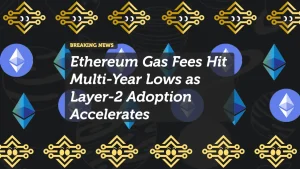
Ethereum Exit Queue Hits Highest Level Since 2022 Proof-of-Stake Transition
Ethereum exit queue hits peak high, marking the largest wave of validator withdrawals since the network’s Proof-of-Stake (PoS) transition in 2022. The surge in exits has sparked debate about whether this trend reflects a natural rotation of stakers or an early warning sign for Ethereum’s price and network security.
What Is the Ethereum Exit Queue?
When validators want to stop staking and withdraw their ETH, they must enter the exit queue, a built-in mechanism that controls how many can leave at once. This prevents sudden mass exits that could destabilize the network.
The fact that the exit queue is now at its highest level since PoS launched shows a growing number of validators are choosing to unstake.
Recent Data on Validator Exits
According to Beaconcha.in and Glassnode, the Ethereum exit queue swelled past 12,000 validators this week, representing more than 380,000 ETH waiting to be withdrawn.
This is the highest level since The Merge in September 2022 and the Shapella upgrade in April 2023, which first enabled withdrawals.
Analysts note that while not all exiting ETH will be sold immediately, the trend highlights a shift in staking dynamics.
Why Validators Are Exiting
Several factors appear to be driving the spike:
- Profit-taking: With ETH hovering near $2,450, some validators may simply be cashing out after long lockups.
- Staking yield decline: Rewards have gradually fallen to around 3.2%, making other opportunities more attractive.
- Market uncertainty: Regulatory pressures in the U.S. and Europe have left some institutional validators cautious.
- Operational costs: Smaller validators face higher overhead compared to large staking providers, nudging them to exit.
Implications for Ethereum’s Price
A rising exit queue doesn’t automatically mean selling pressure, but it can signal potential headwinds. If even half of the 380,000 ETH waiting in the queue hits exchanges, that could add to market supply.
Still, Ethereum’s fundamentals remain solid. DeFi activity, NFT transactions, and ETH burn via EIP-1559 continue to offset some of the selling risks. As one CoinDesk report noted, the exit queue surge might simply reflect rotation between validators, not outright market exit.
Network Security Considerations
A large validator exit could also raise concerns about Ethereum’s network security. However, because the PoS mechanism is designed to balance validator participation, the system adjusts smoothly even with thousands of exits.
Moreover, large staking providers like Lido and Coinbase continue to command significant validator shares, meaning Ethereum isn’t at risk of destabilization in the short term.
Looking Ahead: Rotation or Red Flag?
The big question is whether this exit queue surge is temporary or the start of a longer trend. If ETH’s staking yield continues to lag behind other opportunities, exits could remain elevated.
On the other hand, if ETH rallies past $2,800, many exiting validators may rejoin staking pools, shrinking the queue just as quickly as it grew.
Key Insight
Ethereum exit queue hits peak high since the 2022 Proof-of-Stake transition, but context matters. While some selling pressure may follow, the exits appear more tied to profit-taking and yield shifts than a fundamental loss of confidence in Ethereum. For now, Ethereum’s network remains strong, though traders should keep an eye on how quickly those unstaked ETH tokens flow back into circulation.















